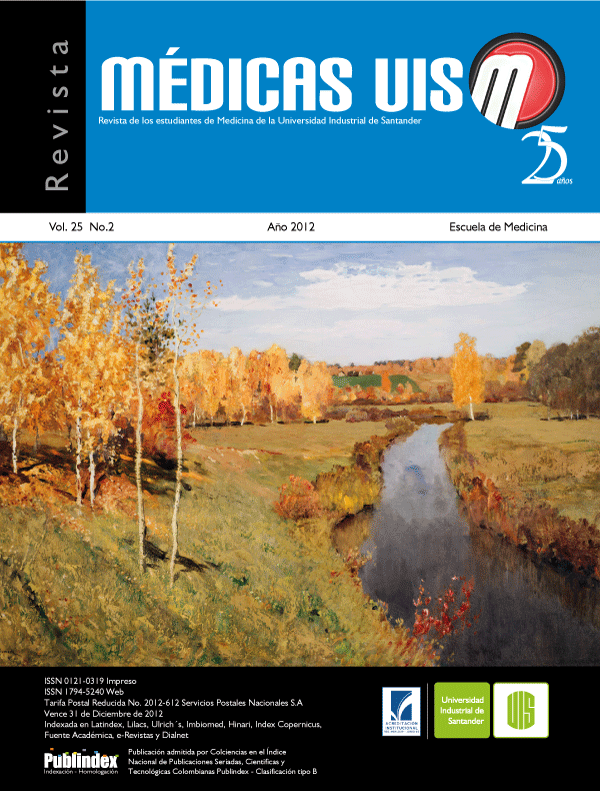Resumen
Este es el reporte de un caso clínico de una paciente con diagnóstico de Síndrome de Stevens-Johnson inducido por fenitoína, quien ingresó a un hospital universitario de tercer nivel en la ciudad de Bogotá, Colombia. Trece días después del inicio del medicamento mencionado por un diagnóstico de síndrome convulsivo focal, la paciente consulta por la aparición de lesiones máculo papulares en cabeza y tronco acompañadas de úlceras orales y genitales. La presentación y distribución de las lesiones, el compromiso sistémico y la asociación temporal con el consumo de fenitoína, apoyaron el diagnóstico de Síndrome de Stevens-Johnson, el cual fue confirmado por el Servicio de Dermatología. La paciente respondió adecuadamente al tratamiento instaurado siendo dada de alta 10 días después de su ingreso sin complicaciones. (MÉD.UIS. 2012;25(2):155-62).
Referencias
2. Rzany B, Correia O, Kelly JP, Naldi L, Auquier A, Stern R. Risk of Stevens-Johnson syndrome and toxic epidermal necrolysis during first weeks of antiepileptic therapy: a case-control study. Study Group of the International Case Control Study on Severe Cutaneous Adverse Reactions. Lancet. 1999;353:2190-4.
3. Chan HL. Toxic epidermal necrolysis in Singapore, 1989 through 1993: incidence and antecedent drug exposure. Arch Dermatol. 1995;131:1212-3.
4. Bastuji-Garin S, Rzany B, Stern RS, Shear NH, Naldi L, Roujeau JC. Clinical classification of cases of toxic epidermal necrolysis, Stevens-Johnson Syndrome, and erythema multiforme. Arch Dermatol. 1993;129:92-6
5. Mockenhaupt M, Viboud C, Dunant A, Naldi L, Halevy S, Bouwes Bavinck JN, et al. Stevens-Johnson syndrome and toxic epidermal necrolysis: assessment of medication risks with emphasis on recently marketed drugs. The EuroSCAR-study. J Invest Dermatol. 2008:128:35-44.
6. Harr T, French LE. Toxic epidermal necrolysis and Stevens-Johnson syndrome. Orphanet J Rare Dis. 2010;5:39.
7. Dunn MJG, Breen D P, Davenport RJ, Gray AJ. Early management of adults with an uncomplicated first generalised seizure. Emerg Med J 2005;22:237-242.
8. McDonagh EM, Whirl-Carrillo M, Garten Y, Altman RB, Klein TE. From pharmacogenomic knowledge acquisition to clinical applications: the PharmGKB as a clinical pharmacogenomic biomarker resource. Biomarkers in Medicine. 2011;5:795-806.
9. Léauté-Labrèzea C, Lamireaub T, Chawkib D, Malevillea J, Taïeba A. Diagnosis, classification, and management of erythema multiforme and Stevens–Johnson syndrome. Arch Dis Child. 2000; 83:347-52.
10. Hung SI, Chung WH, Liu ZS, Chen CH, Hsih MS, Hui RC, et al. Common risk allele in aromatic antiepileptic-drug induced Stevens-Johnson syndrome and toxic epidermal necrolysis in Han Chinese. Pharmacogenomics. 2010;11:349-56.
11. Locharernkul C, Loplumlert J, Limotai C, Korkij W, Desudchit T, Tongkobpetch S, et al. Carbamazepine and phenytoin induced Stevens-Johnson syndrome is associated with HLA-B*1502 allele in Thai population. Epilepsia. 2008;49:2087-91.
12. Man CB, Kwan P, Baum L, Yu E, Lau KM, Cheng AS, et al. Association between HLA-B*1502 allele and antiepileptic drug-induced cutaneous reactions in Han Chinese. Epilepsia. 2007;48:1015-8.
13. U.S Food and Drug Administration [en línea]. Silver Spring; noviembre 24 2008 [actualizado junio 19 2009; accesado febrero 7 2011]. Phenytoin (marketed as Dilantin, Phenytek and generics) and Fosphenytoin Sodium (marketed as Cerebyx and generics). Disponible en: http://www.fda.gov/Safety/MedWatch/SafetyInformation/SafetyAlertsforHumanMedicalProducts/ucm094919.htm.
14. U.S Food and Drug Administration [en línea]. Silver Spring; noviembre 24 2008 [actualizado septiembre 16 2010; accesado febrero 7 2011]. Phenytoin (marketed as Dilantin, Phenytek and generics) and Fosphenytoin Sodium (marketed as Cerebyx and generics) - Healthcare Professional Sheet text version. Disponible en: http://www.fda.gov/Drugs/DrugSafety/PostmarketDrugSafetyInformationforPatientsandProviders/ucm124788.htm.
15. Calderón-Ospina CA, Urbina-Bonilla A. La Farmacovigilancia en los últimos 10 años: actualización de conceptos y clasificaciones. Logros y retos para el futuro en Colombia. MÉD.UIS. 2011;24:47-63.
16. Ferrándiz-Pulido C, García-Fernández D, Domínguez-Sampedro P, García-Patos V. Stevens-Johnson syndrome and toxic epidermal necrolysis in children: a review of the experience with paediatric patients in a university hospital. J Eur Acad Dermatol Venereol. 2010;25:1153-9.
17. McGee T, Munster A. Toxic epidermal necrolysis syndrome: mortality rate reduced with early referral to regional burn center. Plast Reconstr Surg. 1998;102:1018-22.
18. Garcia-Doval I, LeCleach L, Bocquet H, Otero XL, Roujeau JC. Toxic epidermal necrolysis and Stevens-Johnson syndrome: does early withdrawal of causative drugs decrease the risk of death? Arch Dermatol. 2000;136:323-7.
19. Viard I, Wehrli P, Bullani R, Schneider P, Holler N, Salomon D, et al. Inhibition of toxic epidermal necrolysis by blockade of CD95 with human intravenous immunoglobulin. Science. 1998;282:490-3.
20. Schneck J, Fagot JP, Sekula P, Sassolas B, Roujeau JC, Mockenhaupt M. Effects of treatments on the mortality of Stevens-Johnson syndrome and toxic epidermal necrolysis: a retrospective study on patients included in the prospective EuroSCAR Study. J Am Acad Dermatol. 2008;58:33-40
21. Bachot N, Revuz J, Roujeau JC. Intravenous immunoglobulin treatment for Stevens-Johnson syndrome and toxic epidermal necrolysis: a prospective noncomparative study showing no benefit on mortality or progression. Arch Dermatol. 2003;139:33-6.
22. Wolkenstein P, Latarjet J, Roujeau JC, Duguet C, Boudeau S, Vaillant L, et al. Randomised comparison of thalidomide versus placebo in toxic epidermal necrolysis. Lancet. 1998;352:1586-9.
23. Namazi MR. Increased mortality in toxic epidermal necrolysis with thalidomide: corroborating or exonerating the pathogenetic role of TNF-alpha? Br J Dermatol. 2006;155:842-3.
24. Lissia M, Figus A, Rubino C. Intravenous immunoglobulins and plasmapheresis combined treatment in patients with severe toxic epidermal necrolysis: preliminary report. Br J Plast Surg. 2005;58:504-10.
25. Meiss F, Helmbold P, Meykadeh N, Gaber G, Marsch W, Fischer M. Overlap of acute generalized exanthematous pustulosis and toxic epidermal necrolysis: response to antitumour necrosis factor-alpha antibody infliximab: report of three cases. J Eur Acad Dermatol Venereol. 2007;21:717-9.
26. Trautmann A, Klein CE, Kämpgen E, Bröcker EB. Severe bullous drug reactions treated successfully with cyclophosphamide. Br J Dermatol. 1998;139:1127-8.
27. Arévalo JM, Lorente JA, González-Herrada C, Jiménez-Reyes J. Treatment of toxic epidermal necrolysis with cyclosporin A. J Trauma. 2000;48:473-8.
28. Simões A, de Freitas PM, Bello-Silva MS, Tunér J, de Paula Eduardo C. Laser phototherapy for Stevens-Johnson syndrome: a case report. Photomed Laser Surg. 2011;29:67-9.
29. Bates D, Leape L. Adverse drug reactions. En: Carruthers SG, Hoffman BB, Melmon KL, Nieremberg DW. Melmon and Morelli ́s Clinical Pharmacology. 4th ed. New York: McGraw-Hill;2000. p. 1223-56.
30. Bastuji-Garin S, Fouchard N, Bertocchi M, Roujeau JC, Revuz J, Wolkenstein P. SCORTEN: a severity-of-illness score for toxic epidermal necrolysis. J Invest Dermatol. 2000;115:149-53
